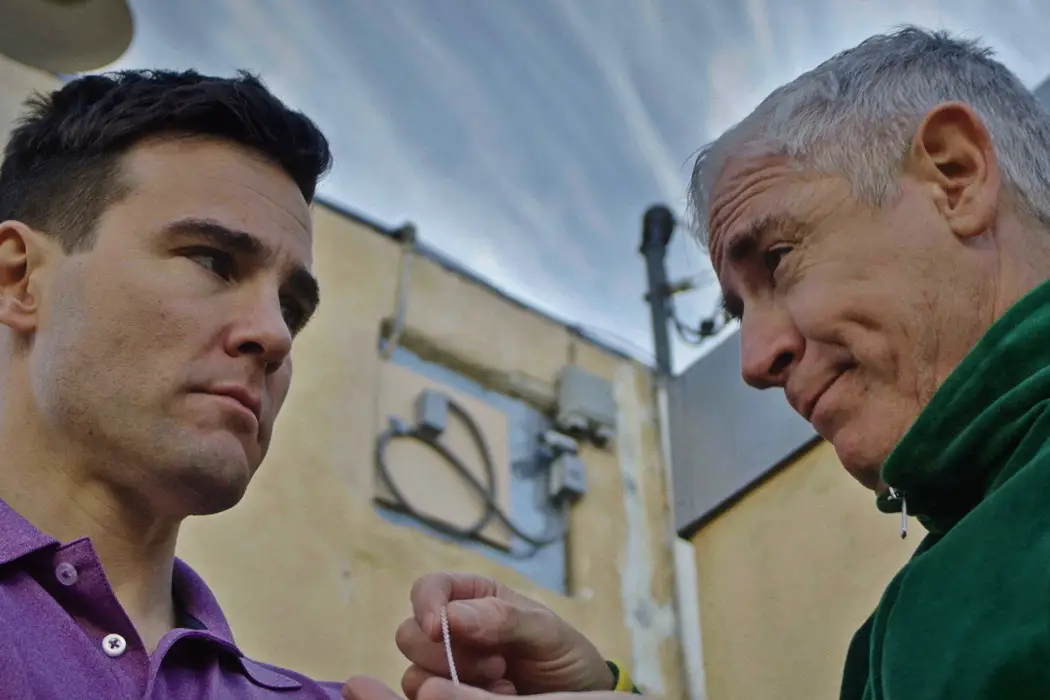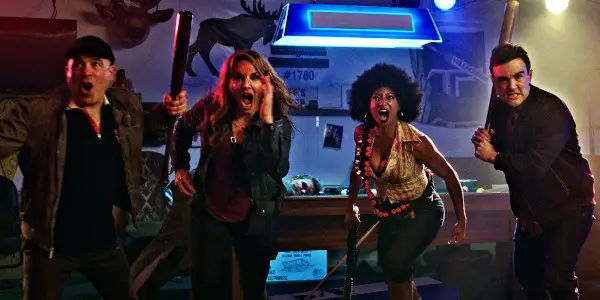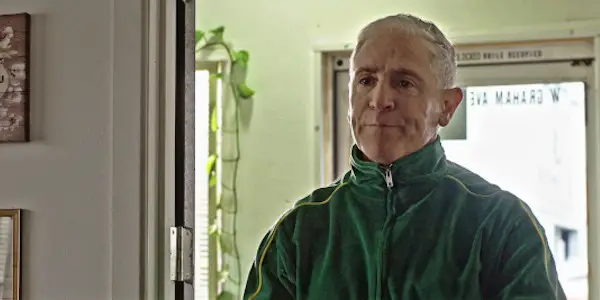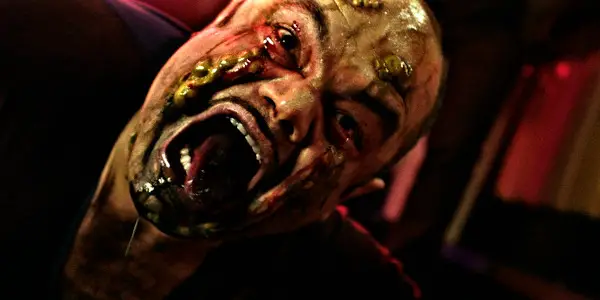Interview With Carlos Alazraqui, Co-Writer And Star Of WITNESS INFECTION

Luke Parker is an award-winning film critic and columnist based…
I told Carlos Alazraqui – the iconic voice actor behind characters like Rocko, Spyro the Dragon, Mr. Crocker, and the Taco Bell chihuahua – that writing out this interview as a transcript was like putting a symphony recording inside a glass case; it didn’t do the form justice. And I was absolutely right.
Our conversation about his latest project, the zombie mobster flick Witness Infection, was hijacked by many different personas, all from the same mouth, but each from different corners of my childhood memory bank. Perhaps the most difficult part of the interview was muting my laughter and giddy excitement to preserve the recording.
Alazraqui stars as Don Serrelli, the leader of the Serrrelli crime family in suburban New Jersey. As the film begins, he’s attempting to coerce a truce with the Miola family through the arranged marriage of his son, Carlo (Rob Belushi), and the Miola daughter, Patricia (Erinn Hayes). The possibility of a holy matrimony is stymied, however, once a vicious batch of sausage renders the entire mob community useless… at least as humans. Soon, Carlo and his friends (co-writer Jill-Michele Melean, and Bret Ernst) are left to navigate a field of the Italian walking dead.
Film Inquiry spoke with Alazraqui about his experience writing and starring in the film, how he stayed ahead of the genre’s creative curve, and what voice actors bring to live-action roles.
This interview has been edited for clarity.
Luke Parker for Film Inquiry: Your collaboration with Jill-Michele Melean stretches back years, across Reno 911! and several comedy tours. Has a movie been on your guys’ to-do list for a while?
Carlos Alazraqui: Not for a while. We knew that we liked doing projects together. She wrote a movie called This is Meg that was sort of autobiographical about her life as a comic trying to make it. She made me a part of that, and I did some other things that she was a part of, like little sketches. We did this thing call Killer Cocktail with Jim Ojala – it was a bar in hell. I played the devil and she played my sidekick, and we would host horror movies. A lot of those great classics. I grew up with Bob Wilkins and Creature Features when I was a kid in the San Francisco Bay area.

I don’t know what it was. She sent me some scripts to read through because she’s a writer. I’ve always been the ideas guy. I’d written a few things before but she had the structure down, and I really liked what she wrote. I thought it was cool idea because we used to hang out as comics and go to cemeteries during the day. We had the same mindset.
It wasn’t always on our radar, but it just kind of popped up after she sent me her scripts a couple of years ago. I originally had this idea about zombies and mobsters. She liked The Sopranos and we liked Shaun of the Dead, so we said let’s do it! And it just jelled. It just worked.
This isn’t just a horror-comedy, like you said, it’s a mobster horror-comedy. What about the fusion of gangsters and zombies appealed to you?
Carlos Alazraqui: I don’t know. I love the concepts of both types of shows. I always loved The Sopranos. We loved Shaun of the Dead. I love zombie films. I love Dead Snow. I even love Lederhozenzombies.
I was born in Yonkers, New York. My parents are from South America. My wife is from Jersey. I always liked the Italian thing. I did characters like that in voiceover and stuff, so it was always right there, you know?
I always thought, what if you mixed the two genres together? And that’s where we came up with the line in the movie, “always leave one in the head.” It’s perfect for a zombie film. You gotta shoot the zombie in the head. The quote’s Jon Polito, I think he passed away. I got to meet him actually on a Nickelodeon show. Jon Polito from Miller’s Crossing: “never shave with a cold razor and always leave one in the head!”
That also sounds like Zombieland. That’s one of the rules: The Double Tap.
Carlos Alazraqui: Yeah! Zombieland with Woody Harrelson. But what proceeds it is actually those mob guys. That’s also from the great “Pine Barrens” episode of The Sopranos where they took the Russian guy out to the woods to kill him, and they bang him over the head with a huge remote control. But when they get there, he’s still alive in the trunk! You got to leave one in the head.
The zombie movie has been off and running since George Romero in the ‘60s. As a writer jumping headfirst into the genre, how do you stay ahead of the creative curve?
Carlos Alazraqui: You have to hit the nail on the head and say, “it’s more than homage, we’re going to borrow that.” We really emulated Shaun of the Dead. We really looked at that script and studied it, and asked what works here? They don’t see zombies until like page 35. They slow-burn the story. Simon Pegg‘s character has a nice arc. Nick Frost doesn’t really change, which is hilarious. But we have some great stuff to borrow.

What makes it unique and how you get ahead of the curve is that you write for your friends. Vince Donvito is one of my really, really close friends. And I know who Vince is. She knew Bret Ernst, and I knew who he was from comedy. Rob [Belushi] was the loose cannon. I met him and Tim Stoltenberg at a virtual acting workshop that they taught and I said he’d be a good, solid lead. We didn’t know what he was going to bring. Would he bring that Simon Pegg energy? Or would he bring a more metal, leading man energy?
Jill was also a wild card too. It turns out her dramatic chops take over in this movie. She’s the least straight person of them all amongst the three, Vince being the goofiest. But I think what made it easy to be different was writing for our friends.
The thing we were trying to make unique were the shoutouts, the puns, and the zombie kills. We’re on a low budget using practical effects and some digital effects, so we need maybe three good kills and one that’s super unique that we haven’t seen before. And I had an idea for one that’s never been done before. That’s how we get ahead of the conceit that’s been done so many times.
That’s why I watch movies like Dead Snow and Lederhozenzombies. I know what’s going to happen, but how creative are the filmmakers going to be?
And our own source of infection had to be unique too. That led into Jim Ojala‘s – who’s worked on Strange Nature and Dead Girl– approach to make a unique zombie boil that’s a little bit different from what we’ve seen before. A little bit different from The Walking Dead. Do we do slow zombies or fast zombies? Are they ragers like 28 Days Later? Or are they medium zombies?
Those are the important questions to be asking because they’ve taken so many forms over the years. But speaking of the creative curve…zombies by sausage. I haven’t heard that one before. What’s the history there?
Carlos Alazraqui: We needed to come up with something unique! Lederhozenzombies is poison water. I think Walking Dead is pretty much meteor radiation, like George Romero in Night of the Living Dead. World War Z or even Zombieland, I don’t know what the source of infection is. Or even The Dead Don’t Die.
We knew it was going to be something that the Italians love to eat. And it has to be sausage because sausage is already gross in the context of what it is: dead animals ground up and put into an intestinal case. That’s not great for the body. It’s delicious but…
So we said, of course, it’s got to be Italian sausage!
You mentioned earlier writing for your friends. But obviously, you both (you and Jill) have starring roles in this film, so you’re also writing for yourselves. When it came to writing your characters, were you mostly doing yours and Jill doing hers? Or since you two have known and worked with each other for so long, do you know how to write to each other’s strengths?
Carlos Alazraqui: We know how to write to each other’s strengths, although I was writing myself to play Carlo, the lead. And then in casting, I spoke with Allyson Bosch, who worked on According to Jim and a bunch of animation that I’ve done, said it was going to be hard to find someone to play my father who was the right age that we could afford. So I just switched it and said, “ah, I know this guy. I’ve seen this father type. I think I know what I’m doing.” But Carlo was written for me.

I knew how to write for him because that was for me. And then Rob put his spin on it. I think he played it very subtly, and it works because his family is crazy! And we need that anchor, the one that we look to and say, “you’re the sane guy. Everyone else is nuts! What’s going on?”
This cast features so many other prolific voice actors that I can only imagine it was done on purpose. As a voice actor yourself, but also as a witness to so many others, what does regular voice acting add to a performer’s skill set?
Carlos Alazraqui: The ability to give a character age and context immediately. We’ve done these characters before, especially Maurice [LeMarche]. “You need an Italian guy. How old do you want him?” We know how to at least put together that voice and place the character right away. That’s what we do. So, it’s very fast.
You have an entire vault of beloved animated characters in your head – a quick look at your IMDb page tells me you have well over 300 credits. I’ve seen interviews, and you’re even doing it today where you just spout off a whole lineup of characters one after the other. But when you’re in the recording studio, prepping for scenes, is there a process of getting into character?
I think the best way to witness Carlos’ response to this question is to hear it for yourself…
Film Inquiry thanks Carlos Alazraqui for his time.
Witness Infection is available to stream now on a number of digital and cable platforms.
Does content like this matter to you?
Become a Member and support film journalism. Unlock access to all of Film Inquiry`s great articles. Join a community of like-minded readers who are passionate about cinema - get access to our private members Network, give back to independent filmmakers, and more.
Luke Parker is an award-winning film critic and columnist based in the Baltimore-Washington metropolitan area. As an entertainment journalist, he has interviewed several members of the film industry and participated in some of its most prestigious events as a member of the press. Currently, he is working to obtain his bachelor’s degree in Mass Communication at Towson University.













